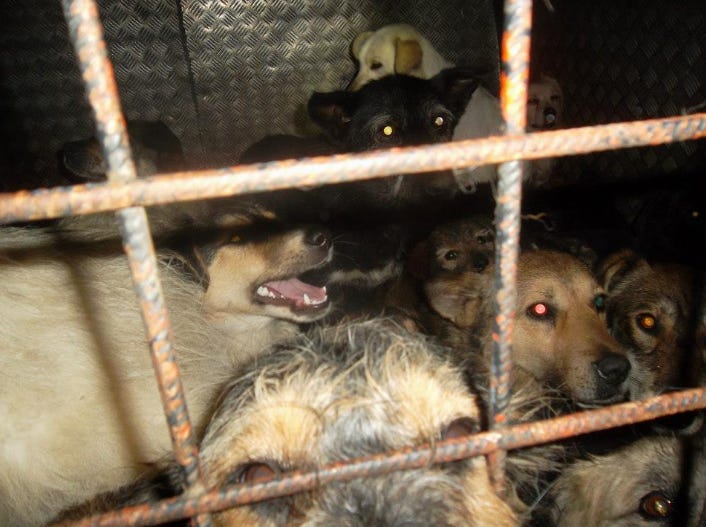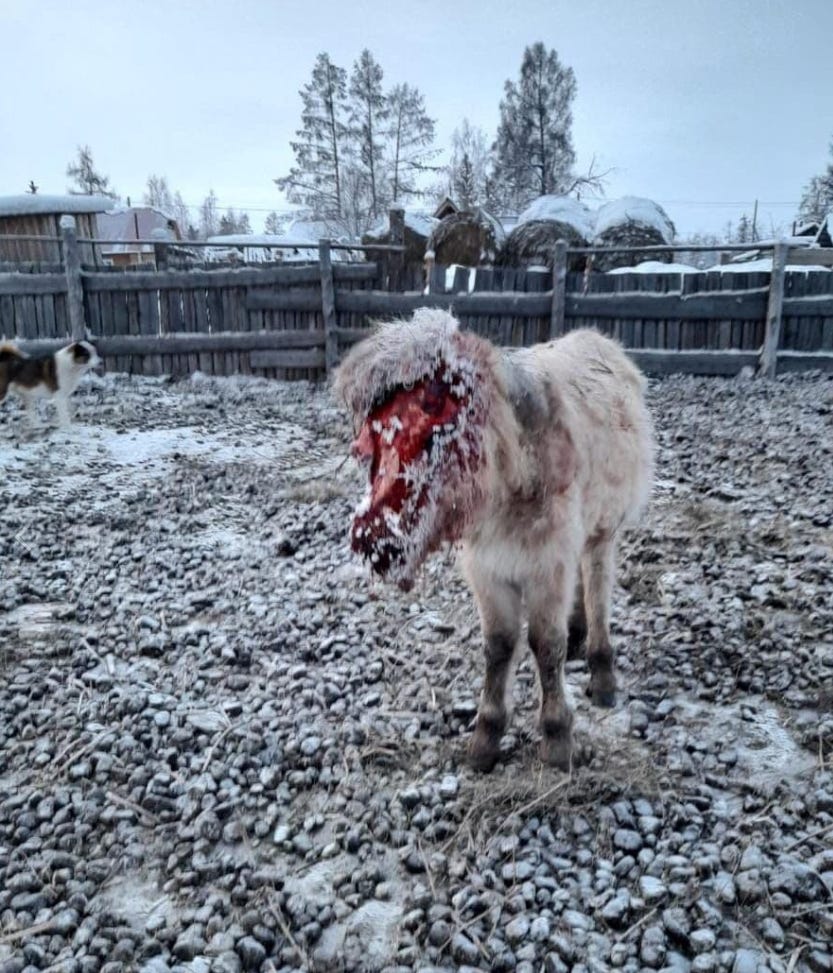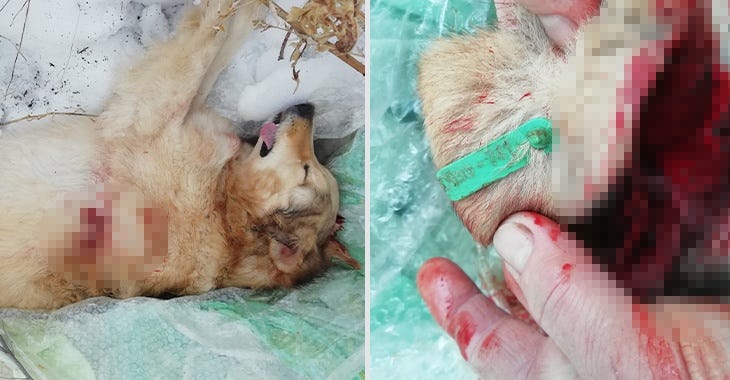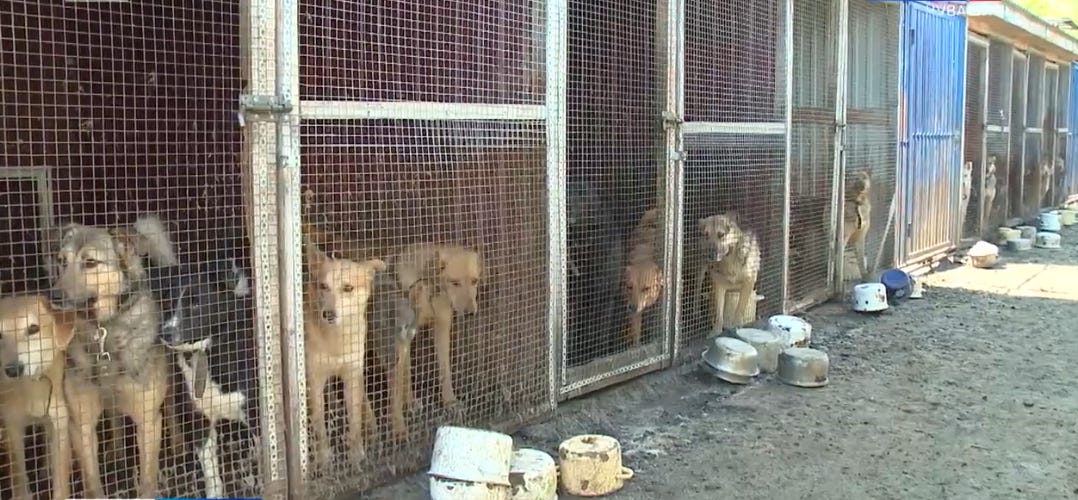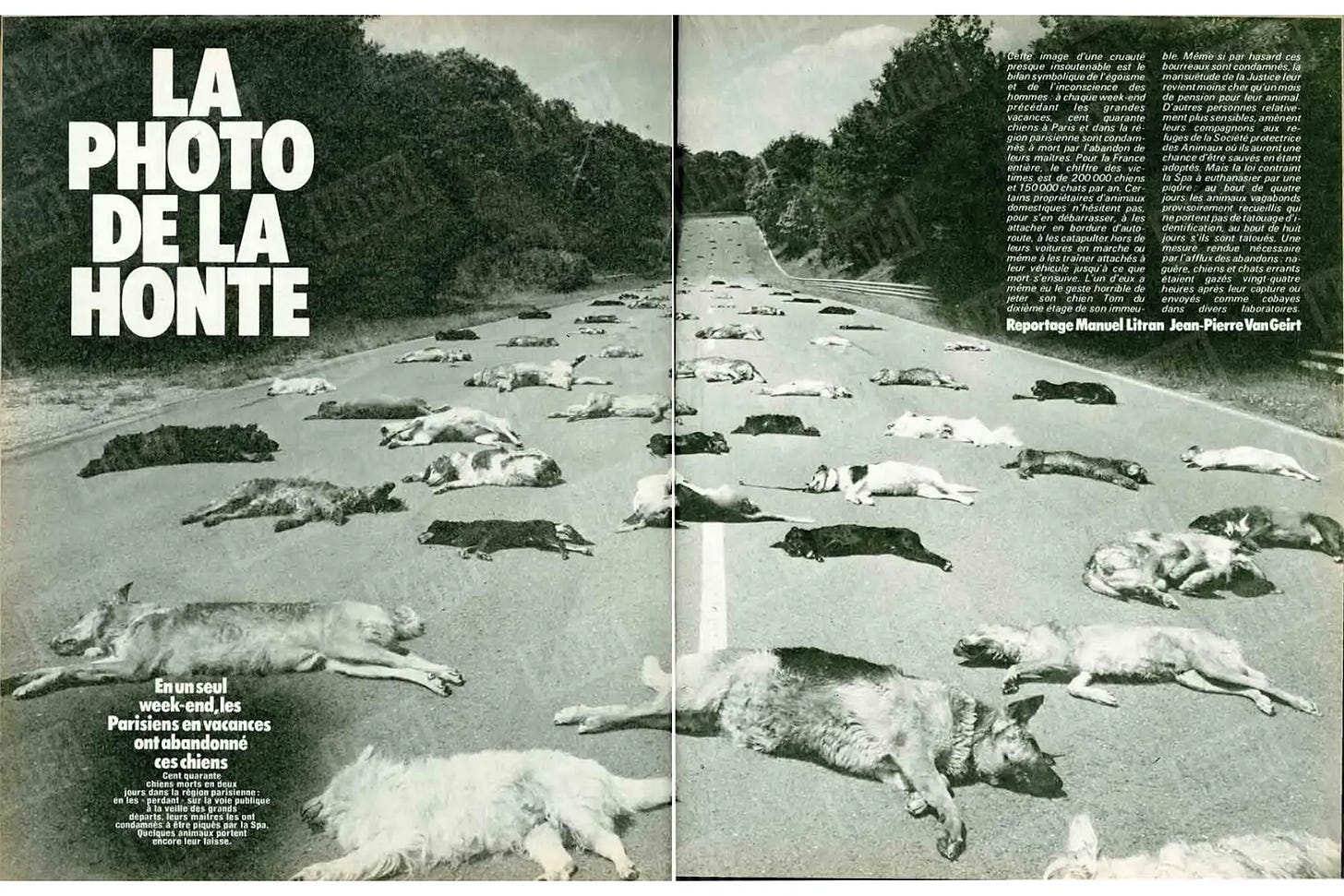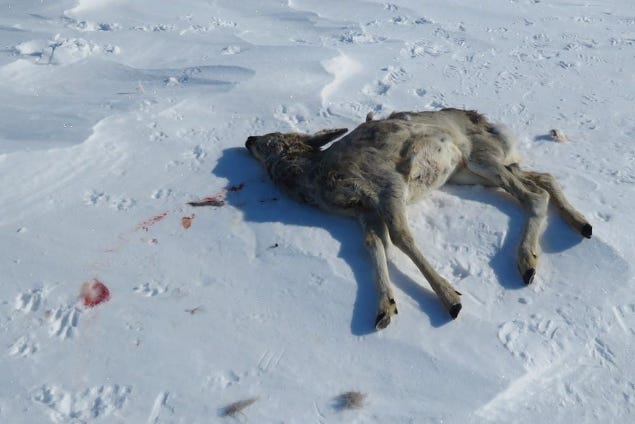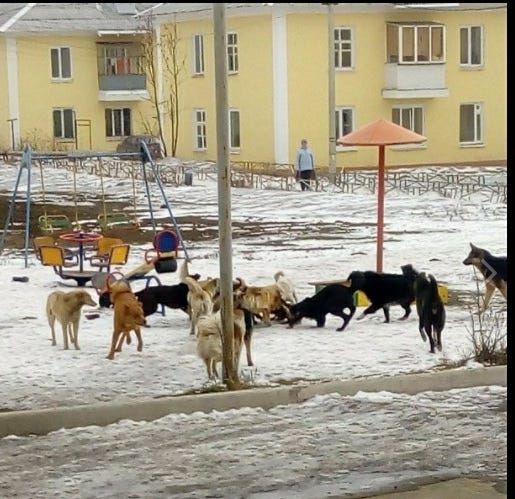Trap neuter Release Utopia
An analysis of failures in policy and communication of Western NGO's on the topic of CNVR (Catch Neuter Vaccinate Release) for stray dogs. The results of silence on the topic of euthanasia.
Hundreds of thousands of unsocialised dogs are suffering in concentration camp-like shelters across Eastern Europe. In other cities, streets are still getting filled with a growing population of stray dogs, attacking and even killing people, causing a vigilante backlash and cruel killings. All of this is in accordance with enshrined laws and as a result of certain myths and unsaid truths from those who claim to have achieved success..
The situation didn’t occur because of bad intentions. However exploring the issue frankly is vital for the sake of millions of animals, who are suffering and will continue to suffer if the issue is left unadressed. PART 1 describes what is going on and how we got here. PART 2 has more detail and nuance for NGO employees in the space. Recommendations are included in the conclusion.
Whilst the concrete examples discussed here are across broader Eastern Europe and surrounings, potential implications outside of Eastern Europe (e.g. Asia or South America and other emerging markets) should be further explored, but this is outside the scope of this article.
Public shelter in Romania
PART 1 – ‘THIS IS HOW TO BE HUMANE” (if you can afford it)
If I am an animal charity from a ‘medium human development’, but not ‘rich’ country, for example Ukraine/ Romania/Turkey or Russia, and I want to improve the situation with large amounts of stray dogs in my country: Who do I go to for guidance on how it is done? I go to the most successful Western organizations who have spent time and money doing projects abroad and are from countries where there are no stray animals and animal welfare is advanced. Luckily they have written guidance documents on what people like me should do to resolve issues with large numbers of stray dogs.
How are they doing it and what are they saying?
They finance CNVR (Catch Neuter Vaccinate and Release back on the street) programmes in selected towns of some countries around the world. They promote CNVR programmes for dogs as an effective and most humane method that has worked elsewhere. They have full guidance on dog population management, explaining how everything should happen in theory. After all, they made it work somewhere (using large grants) .
Clearly if I look at the countries that these organizations are from (Europe, UK, US) and I look at how animals are treated there, I think they have the problems pretty much sorted and it looks like paradise to me. So clearly I will listen to what they have to say about what I should propose my government does with our stray dogs.
I see these charities talking about a humane approach as the only way. I read “humane” as no-kill because how can “killing” be humane? No one has taught me this part and no one ever will,as it is not on anyone’s agenda to talk about how open admission shelters with euthanasia can be the humane alternative under many conditions and what part it has played in achieving the great situation the countries who pursued it, have now.
Releasing stray dogs without a supply of food resulting in attacked farm and wild animals and destruction of millions of cats .
But most importantly, what do I not see if I look at their guidelines and writings?
I don’t see any information that in Western countries euthanasia of healthy surplus animals was commonplace and, in some places, still is (although much reduced).
That without this mass euthanasia, the situation would have arguably been different.
That it took DECADES and hundreds of millions of $/Euro/£ of expenditure by philanthropists to grow the animal welfare NGOs and provide discounted/ free neutering for Companion animals of low income population.
That this growth of shelters and making them attractive to visit, was happening WHILE mass euthanasia was happening so the strained animal welfare people and NGOs had the breathing space to develop as opposed to jumping from one emergency and overcrowding to another.
I would see that the government in most countries didn't contribute finances beyond catching services and would not consider or fund neutering of street dogs and returning them to the streets. One of the reasons being public safety and acceptance.
I would see that ALL shelters that keep animals longer than 2 weeks are privately funded.
That no Western city will tolerate stray dogs on the streets or introduce dog catch neuter vaccinate release (CNVR) as a method to reduce stray dog population.
I would also see that CNVR of Dogs does not have evidence of having worked anywhere in the world outside of specific, contained areas and under specific conditions - small islands, Asian style of animal keeping (all dogs are community dogs) OR when combined with non-return capture programme as was done in some countries of Southern Europe. In addition, a huge multi-year expenditure is funded by foreign organizations.
Let’s also forget the reality that all CNVR ideas are proposed from wealthy countries with functioning democracies with low levels of corruption, but aimed at countries which have anything but this situation.
Dog from CNVR programme killed by vigilante
Poisoned dogs (Daily find in Russia, Bulgaria and Ukraine (pre War)
So the typical animal welfare advocate from Ukraine/ Russia/ Serbia/ Romania/ Bulgaria etc sees half a picture that looks good “hey, it’s all possible to be humane and kind now, the way forward has apparently ‘worked’ somewhere. (nevermind the conditions and finances (to be discussed further)
They want to be “humane”, of course, and the western charities tell them that euthanasia is only the last resort ...Nothing and no one talks about how euthanasia, as part of a plan to realistically reduce stray population, can be humane and necessary and has been used in Western Europe for decades and is still used in some countries including the USA
The activists in Eastern Europe are getting this false picture showed to them, that is completely unachievable given the realities of their countries (applies to most in all cases):
initial large population of dogs, mostly large-sized and dangerous to people
poor shelter infrastructure
issues with availability of educated vets and affordable anesthesia
low income level of population
non-existent buffer in reserves in animal welfare philanthropy - sector is completely undeveloped
corruption
Western style of dog and cat ownership as opposed to developing world (every dog is a community dog)
Majority of the population inherently don’t like street dogs and don’t want them there for reasons of safety and / or sightliness.
From this starting point of utopia, they then go and blame the government (and we by no means are on the side of those governments who aren’t striving to resolve these problems) who 'just kills' and 'doesn’t execute proper CNVR' or is corrupt.
Where in the world has a government ever executed proper CNVR of dogs? Maybe in London/ Paris/ Stockholm or Vienna, where they clearly have the funds and ‘ethical’ development to do so, they released thousands of dogs back on the streets?
In addition, if not CNVR, which government will spend the same on dog shelters as their education budget, when a large percentage of their people are living below poverty level?
Wouldn’t it be better if the Western orgs said honestly - our ideal humane construct and the result we now have in the UK, Germany etc is impossible in your country unless it has XYZ? You need to start where we started (limiting street numbers to a more manageable amount for your population, using a non-return shelter system) and not put the cart before the horse. With patience and work with the population over some years you will grow out of lots of euthanasia to near 0, but that initially you can’t do without it. And you definitely cannot do any constructive population work if there are just too many animals - because as an animal person this is what you are going to do first - hoard and try and rescue all the surplus animals! At the same time, you are unlikely to have money/ space/time to provide acceptable living conditions to all the animals you rescue. In the alternative case you or your government will be piling up animals in horrid conditions a la concentration camps and / or leaving the animals on the street to attack/ kill children and elderly and kill cats and other small animals This is how you propagate a cycle of hate and vigilantism towards street animals AND the people who try to protect animals. Where is the research paper on THAT after all the dog CNVR programmes that were tried?
Irkutsk , Russia dog shelter after euthanasia ban (pre war)
Another typical shelter in Russia where no one is socializing, water in buckets freezes and food is often your neighboring fellow dog.
However, talking about euthanasia and open admission shelters being a necessary part of dealing with big stray problems is politically incorrect and risks creating online and offline haters, which the PR and fundraising departments of these large charities can’t accept.he large NGO, pushing this policy, prefers to only be linked to ‘humane’ solutions - arguing that euthanasia of healthy animals can be much more humane than the alternative, is risky for reputation and hence donations
Is this because the donor population is considered stupid or unable to follow a line of argument and clearly see how horrid the alternative is?Are they afraid that on balance the donors will respond more to a troll who says that charity is calling to kill all animals more than to a well-argued piece by the charity itself?
We worry this is not even being discussed as the donors are being infantilized and everyone fears the online mob. How much does the common knowledge of ‘things we can’t talk about’ impact our thinking about what is true and right?
Due to the oversight and biased, unexamined communication by ICAM and International Organisations like Humane Society International and others, their recommendations have been misapplied and led to great animal suffering. Our suspicion is that what has gone wrong in Eastern Europe might have also happened in some places in South America, however it is beyond the scope of this article.
Let’s take as an example the latest update from ICAM Humane Dog Population MAnagement Guidance 2019 . In reality this document should come with a bold disclaimer on top , saying only to be used by places that have secured multi year substantial funding from private organizations or said rich private organizations when evaluating and helping design programs. Only to be used by groups that have funding and people for work like a widespread survey and community outreach . If there is no one to do this community and preparatory examination work , then you sadly don’t have a chance to be humane in this lifetime or just better not read these guidelines. Whilst having smart sounding theories, if one probes a bit - it all falls apart on funding, environment, awareness and assumptions.
But what is the alternative, one might ask?
And here the charities become a bit cheeky and don’t mention the widespread success and application of a 3rd option - open admission shelters - a system , whose inherent design already incorporates the ability of a certain region / country to carry a certain amount of dogs. It is not only for the wealthy and backed by large budgets . It has a history , in Western countries, of giving the undeveloped animal philanthropy sector the necessary breathing room to develop nice looking shelters people actually want to adopt from, organize subsidized or free neutering for pets of the poor, do things like social ads and humane education - all unaffordable and unrealistic luxuries for those who have to deal with packs of dogs on the street, no real infrastructure and no end in sight, because CNVR cannot work in those situations .
Western people 20-40 years ago were not less humane than average people in developing countries nowadays . Why did they practice open admission shelters and euthanasia was not a taboo? Is this because of social media and “cancel culture”? Why is no one talking about it? How it made sense, given no one in their right mind would release excess dogs to the city streets and there were budget / infrastructure limits and not enough people willing to house 20-40 animals. And as these limitations improved , the amount of euthanasia dropped, in some places to 0.
The way human nature works is that changes only really occur when a human has either a sense of urgency or a very strong or adverse feeling, like shame, that leads to a realization he cannot continue in the old way.. No one ever changed a strong character trait or won against an addiction because they felt good about themselves . No, they do it only after they feel disgusted with themselves.
How did France change its attitude and from which point better laws were adapted? After the outrage where the French were faced with the final result of their lax attitude to pets
Of course with our overpowering humane instinct we think we can skip this necessary step of societal education into more responsible pet owners. But reality proves different and it's only logical that it would, given an understanding of human behavior and what changes it. When the worst outcome (death for most) is avoided because someone else is ‘taking care’ of the problem , then why would one change into a more responsible owner ? We have seen many animal advocates and shelter owners notice this in Russia - after the euthanasia ban and CNVR introduction was passed, they noticed a sharp decline in volunteer effort across all shelters and more self-walking , releasing dogs out of the house without owners.
Why neuter my pet if the government is going to trap and neuter, then they'll release him back and maybe he'll come back or not, in any case there is no threat of death, so it's ok.
In the nextpart we look at the realities of CNVR in more detail and analyze the technical oversight by ICAM and Western NGO’s: points that should be thought about before recommending a policy in the future. We also explore potential paths to fixing the situation.
Turkey government shelters (but hey - euthanasia is bad):
PART 2 - CNVR Experience (all foreign language research and analytical papers are in the process of being translated to English, for those that still remain untranslated , google translate can be used. All sources used with English subjects and links are listed in the attachment as well)
CNVR has been applied in Eastern Europe and surroundings mostly in Turkey and former Soviet countries, Bulgaria, Romania and in certain cities in the Balkans.
Let's take Turkey, where CNVR for dogs has been legal for more than 15 years. What did this method bring to the country? The answer is in this recent article in one of the larger papers . In short, the problem of stray dogs has remained the same. With all the consequences of that. Including the recent death of a child from rabies after being bitten by a street dog. In response , there were bursts of illegal cruel destruction of the dogs. CNVR also brought extreme polarization of public views on how to solve the problem. Endless and fruitless debates continue, in which mutual hatred boils between those who are in favor of the extermination of dogs and the CNVR animal protectionists. The country is at a dead end with no visible way out. The author of the article writes about this with concern.
The largest post-Soviet countries that use CNVR as the main method for dogs are Russia and Ukraine. Kazakhstan has only recently begun to apply CNVR, while in Belarus this method is not used for dogs.
Let’s take Russia as an example. In the Soviet Union and during the transition period, either the destruction of dogs happened immediately upon capture, or after a short stay for three days and then destruction was used. Moreover, painful muscle relaxants were used without anesthesia (death by asphyxia basically, lasting several minutes). There were less strays than now, but the effect on the number/ reduction of strays was limited, since the catchers were unprofessional, were interested in a quick continuous income, and therefore left part of the dogs so they could breed, and people hid the other part of the dogs, saving them from death. The animal welfare movement as a whole grew out of opposition to such regulation. 20 years ago activists had neither knowledge nor experience.
Having learned about experiments with CNVR in India and the countries of Southern Europe, Russian activists immediately decided to introduce it in the country. At the same time, many of the preliminary measures that are written about in the current ICAM recommendations were not applied as for those measures to be applied a certain level of development and wealth is needed as we will see. For example, there were no studies on the nature and extent of problems caused by stray dogs, sources of replacement of the number of stray dogs, the theoretical basis of the CNVR method (for example, the required minimum % of neutered bitches over a determined period of time in order to be significant enough to be effective), no comparison study of different places using CNVR in the world, and the real experience of dealing with dog overpopulation of Western type of dog keeping countries (majority of dogs are kept inside/ belong to an owner and are not ‘community’ dogs).
THE MAIN MOTIVATION OF CNVR INTRODUCTION WAS THE POSSIBILITY OF ALLEGEDLY ENDING THE KILLING IMMEDIATELY.
Moreover, the motive was brought to the most radical extreme - the possibility of introducing humane methods of euthanasia as a better alternative for the animals, the reasons for it, etc. were not even considered. Putting a healthy animal to sleep, for whatever reason, was demonized and rejected unconditionally. Since no one carried out work on the study of the theory of CNVR and its history of practical application, a completely distorted point of view on the CNVR method prevailed widely, which later formed the basis of the national legislation on animals. For some time, the thesis was even widely circulated that it was the CNVR that led to the sorted situation in Western countries, which is completely false.
Destruction of millions of cats and hundreds of thousand wildlife
The first experience of using CNVR in Moscow for 8 years ended in a complete failure . Scientific counts of the number of stray dogs were carried out, which showed an increase in the number of 1.5 times over 6 years. The number of pack attacks on people has sharply increased, 3 deaths have been recorded. Other animals suffered greatly from the attack of packs: wild animals (from ground birds to elk) in urban forests, as well as street cats, almost completely exterminated by dogs . Finally, a phenomenon arose that even received its own unique name: dog hunters - people who independently brutally exterminate stray dogs under the pretext of ensuring the safety of themselves and their loved ones.
Typical kids’ playground in Russia
The CNVR program in Moscow was closed in 2009 by the authorities and replaced by intensive capture of animals in huge shelters, 1500-3000 dogs in each, resembling concentration camps. This measure alone reduced the number of stray dogs by several times in about 2-3 years.
However, NO conclusions were drawn from the CNVR failure in Moscow. The state has not created an expert council under any authority that would allow us to analyse the experience of Moscow. The same lobbyists supporting =CNVR went to the federal level, and 8 years later the Federal Law of Russia was adopted, where CNVR was declared the main method.
The consequences of it today are extremely negative, including numerous cases of human deaths. For example, only in the winter-spring of 2022, people died in the regions: Yakutia, the Trans-Baikal Territory, Astrakhan. Against this background, injuries and illegal cruel extermination of dogs have grown. A decrease in the number is recorded only where, instead of or together with the CNVR, certain methods of irretrievable capture are used. These are the so-called gray schemes (for example, taking animals to other cities or to the countryside), or accumulation in shelters.
In this regard, it is bewildering that this negative experience has not been properly analyzed by international organizations either, although something similar has happened before (for example, in Romania, which eventually abandoned CNVR and stuffed the animals e in shelters with dubious quality of life and no socialization). In Moscow, a system of shelters was adopted with funding 20x the size of similar Russian cities, thousands of dogs packed 2 stories defecating on top of each other in some instances. Concentration camp-like situation but not CNVR and no euthanasia. Plenty of suffering and death because of inadequate care though.
Although the current ICAM recommendations warn of several features of CNVR, they do not disclose or list them in full, and do not say anything about examples of failures of this method. The OIE guidelines have a more substantial caveat about the limitations of TCO if pet dogs are to be treated responsibly (“TCO as a possible bad example of treatment”), but this caveat is too short and vague.
In general, it must be recognized that from the point of view of animal welfare and the safety of people inextricably linked to it, CNVR is neither the only method, nor even possible to use in some cases. While citing as unacceptable and deservedly stigmatizing such approaches as culling or life-long placement in shelters, the ICAM recommendations do not explicitly state that they may arise also as a direct consequence of the political decision to introduce CNVR and the complete ban on euthanasia. While the correct, honest positioning of euthanasia among acceptable methods, as well as the same correct and honest positioning of irretrievable capture (not as a kind of culling, but trapping in shelters and the subsequent individual decision on the fate of the animal) could prevent many tragedies and dead ends. It must be frankly admitted that in some cases CNVR can be just as inhumane and ineffective as the above approaches.
But so far, this is not in the recommendations, in particular:
- there is no mention of mathematical modeling, although most mathematical models indicate that regular capture without return is more effective than CNVR (with an equal share of animals caught for each of the methods). There is no honest admission that under CNVR, stray dogs will remain a presence on the streets forever.
- in addition to describing different types of stray dogs, there is no link to specific geographical differences between specific countries. There is no differentiation between the most common styles of keeping dogs: European and Asian. There are no smaller but important details: for example, in Russia and Ukraine there are practically no classic community dogs typical of the residential areas of Asian and African countries, but there is an extensive group of conditionally controlled dogs of enterprises and organizations that live in enclosed industrial areas. Moreover, the types of urban environment themselves in these countries can differ greatly from those in countries where CNVR is traditionally used (India, Turkey).
- examples of unsuccessful applications of CNVR are not given. And among the successful ones, those that do not fully correspond to reality (more on this below) are mentioned. is a lack of critical thinking approach to information sources, which, as a rule, are the local executors of the CNVR themselves. For example, the case of Odessa (Ukraine), according to ICAM, indicates a decrease in the number of stray dogs from 50,000 or 80,000 (!) individuals to 3,000-4,000 after the application of CNVR. In reality, scientific counts of the number of dogs in Odessa were not carried out at the beginning of the CNVR campaign, the value is purely speculative, it looks absolutely unreliable in comparison with cities of a similar size, in the same conditions, but where the counts were carried out (for example, Moscow, Kharkov, Nizhny Novgorod, Rostov-on-Don, etc., in all of them, there was about 1 stray dog per 200-300 inhabitants, even in the worst years, and in Odessa this figure is for some reason much higher!). In the experience of Odessa, the fate of the puppies was not accounted for or noted, which, during CNVR (captured mother), either remain on the street or disappear without a trace in an ‘unknown direction’. Also not mentioned are numerous cases of dog poisoning in the city that occurred until very recently.
- no examples are given of the successes of cities that did not conduct CNVR but used the Western approach (placing in a shelter and an individual decision of fate without returning to the streets with the admission of euthanasia according to indications and when the shelter is getting too full – TAKING ACCOUNT OF AVAILABLE RESOURCES). For example, Kharkiv, which has the smallest number of stray dogs among the major cities of Ukraine, and the complete absence of dog hunters. (Data and links on Kharkiv are included further in the article). Moreover, in the city there have been numerous counts of dog population with the participation of international organizations, and the reporting of the shelter is transparent and unequivocally allows one to judge the fate of the dogs (without hidden killings being conveniently being left out , like is often the case with any analysis of CNVR).
- the interspecies relations of dogs and other animals are not considered at all. Meanwhile, stray dogs, especially in the northern regions, having a noticeable admixture of hunting breeds, begin to hunt other animals, in particular, cats. This hunting has no ecological justification, as the dogs do not eat their prey, but hunt for fun. It happens that attempts to conduct simultaneous CNVR for dogs and cats in the same city lead to the quick death of all cats from dog attacks, which means deep disappointment and despair among cat lovers, a waste of resources and hatred for dogs.
- the mentality of the inhabitants of countries such as Russia or Ukraine is opposed to the fact that homeless life is normal for animals, many remember the times of the USSR, when stray dogs were practically not seen. In addition, social advertising of animal rights activists involuntarily also pushes to the idea of unacceptability of homelessness (“take animals from shelters”, “don’t leave them in dachas”, etc.). But the reality of CNVR cities contrasts with these notions, demonstrating this or that horror of animal homelessness every day. Therefore, a significant part of animal rights activists or simply animal lovers are trying to “rescue” animals from the streets, filling their apartments or shelters with them. The city authorities, also quickly disillusioned with CNVR, are also seeking to leave more and more captured dogs in shelters. But there are not enough resources. It is Moscow that has the ability to spend 2 billion roubles per year for "mega-shelters", other cities and countryside – no, the budget there is 20-40 x less for a proportionally same size city as Moscow.. This leads to terrible overcrowding conditions, turning shelters into “concentration camps” (just one example is the municipal shelter in Ryazan, in which puppies and adult dogs sat together in cramped enclosures, unsterilized dogs bred right between the enclosures in the shelter, there was a huge mortality rate of young animals)
-significant already limited resources, both municipal and charitable, are spent on useless CNVR, and not on shelters, animal rehoming, preferential targeted programs for neutering of domestic dogs, and improving the culture of keeping.
- owners of dogs are misled, their pets are placed in unequal conditions with the homeless (the need to remove excrement after owned dogs, while homeless dogs defecate where they want). The actual encouragement of homelessness provokes the self-walking of owned dogs, without owner.
It seems that the list of positive examples should also include such cases as Kharkiv or Petrozavodsk. There is no CNVR, or it is applied only to closed industrial territories (a feature of the cities of Russia and Ukraine). There is a HUMANE UNRETURNABLE capture, planned, based on monitoring. There are shelters and decisions of individual fate. There is CONTROLLED euthanasia. There is preferential sterilization of domestic dogs. Public education. And there is a registered decrease in the numbers of euthanasia and stray dogs in general. (Links in attachment)
Let’s look at how it got to look like this in Russia and several other Eastern countries: because a volunteer / person at home can provide 5 freedoms for his/ her 30 rescuecats, he/she assume the government can do it too, and basic level of animal welfare movement development DOES mean that these voices get heard and considered by low quality government). The easy carrot to give to soothe these people then is a ban on euthanasia (that’s what they want - no killing!) and shove the CNVR/ shelter issue on local municipalities (without adequate funding) or private sector (which is undeveloped and does not have funding besides some lucky cities ,never countries, who managed to secure a large private grant.
So this volunteer , who has experience at home housing 20 cats and 10 dogs relatively successfully in her eyes, is now pushing legislation . She loves all of them dearly and cannot phantom the concept of humane euthanasia . She finds of course online material from ICAM, HSI and others , showing her it CAN be done, without any euthanasia, because there is this miracle thing called CNVR - ’Look government , if you do xyz , like it says in their guide , the problem would be solved. And if you don’t do it (or if you do and it doesn't work)- it's your fault- you are corrupt , cruel and lazy.’ And that is how we end up with policies that are quick appeasement policies of these scandalous screaming activists with unrealistic expectations waving around ‘research’ , as opposed to policies that prevent animal suffering in the form of increasing stray dog population after / during CNVR and euthanasia ban and all the issues flowing out of that.
There is a city, though, that saw through the falseness of CNVR for dogs, and was the only city to implement a western style open admission shelter - Kharkiv in Ukraine. This was done in 2010 after 2 years of dog CNVR in the city that led to numerous problems. With the new comprehensive open admission shelter approach , they have achieved the best results in the country, that are quite well documented . According to the well known Animal-id.net count in 2020, which carries out counts of stray dogs in cities of Ukraine: counting in Kyiv - 82 dogs per 100 thousand population, in Nikolaev - 928.4 dogs per 100 thousand population, in Odessa -179.8 dogs per 100 thousand population, in Dnipro - 235 dogs per 100 thousand population, in Kharkiv - 43 dogs per 100 thousand population. Frm 2013 to 2020 the amount of requests from the population to remove a dog from the street dropped by 70 percent.
The amount of caught dogs in Kharkiv :
The amount of attacks on humans :
Despite the good results, significant reduction in the amount of dogs that needed to be euthanized and excellent conditions for those remaining in the shelter - the Kharkiv municipal shelter received significant slander and attacks from other animal activists , who have not been educated otherwise as to what actual dog population management and sustainable reduction looks like.
Here is in English "Municipal Animal Service. Choice of strategy." where one can see the integral approach and reasoning.
Due to the lobby of animal rights activists, starting from 11/08/2021 in Art. 17 and Art. 24 of the Law of Ukraine "On the Protection of Animals from Cruelty" the text was amended, according to which the euthanasia of homeless animals in order to reduce their number was PROHIBITED. And, accordingly, it became allowed to release stray dogs to the place of capture after sterilization and clipping, as it is written in the law - "for free living". Since euthanasia was banned , the shelter in Kharkiv started to get overful with unsocialised wild dogs that have 0 chance of being rehomed, just sitting in cages and more animals started to be seen on the streets (even before the war).
Here are more presentations , data and scientific papers from Ukraine showing the honest practical side of what works:
Here is a report at the scientific-practical conference "Homeless animals - a veterinary, medical and social problem in Ukraine. Solution methods”, 2017-
Report to the III International Scientific and Practical Conference "COMPANY ANIMALS IN MODERN SOCIETY: PROBLEMS OF CONTENT AND HANDLING", 2013
"Stray dogs and the ecological situation: the choice of the optimal method for regulating the number of homeless animals" Matsevich L.L.
Report to the II International scientific-practical conference “Problem of homeless animals in Ukraine. Practical methods and recommendations for its solution”, 2012. This report describes how the application of an integrated approach to solving the problem of strays is organized in Kharkov. In this report, it is the presentation that is important - "Castration of stray dogs from the point of view of risk management in an urban environment", Matsevich L.L., is an analysis of scientific works on the effect of castration/neutering on the behavior of bitches and males.
Recommendations for Western NGOs active in stray dog population management
Realization that the current communication and guidance approach of unexamined and non objective recommendation of CNVR that is possible - hasn’t been working and is doing more harm than good.
Group statement, publications on euthanasia having been an integral party of policy in the West to reduce population and realistic assessment of CNVR issues that can be taken from this article. By several charities or 1 ICAM, so not one charity is signaled out by potential trolls.
Advocate the only proven working method over time in Europe to reduce the large stray dog population - comprehensive approach with unlimited admission shelter , like was done in Kharkiv Ukraine till the law started mandating CNVR everywhere in the country and banned euthanasia.
Bring back articles on the importance and humaneness of euthanasia if 5 welfare needs can’t be provided as a system (and spread them in a popular way across emerging market countries). Highlight the minimum (monetary) funds and staffing necessary to provide 5 welfare needs for a large number of animals in a shelter . A paper on what RESOURCES (monetary, people, system) are required to provide them for X amount of dogs to consider Y policy. So there are no illusions.
Don’t fund those who are against euthanasia of surplus animals and keep dragging even sick animals which have low quality of life and chance of rehoming. Make a statement that you don’t fund so they can see what is considered effective animal welfare in places of limited resources.
Fund those who have a realistic approach and create grants for those that do - specifically ask for realistic approaches in funding guidelines. Make it visible, publicize
Be more open about admitting CNVR failures publicly, so others don’t repeat them, instead of presenting the project in the best light, just because many years and funding has gone into it. Charities can only learn from each other if failures are admitted openly. Failure is part of innovation and progress, putting it under the rug just works against it.
To conclude:
With great success and size comes responsibility.
Honesty and Truth often come with unpopular effects.
Deliberate vagueness can be preferred from a purely PR perspective, but has negative consequences for the actual cause.
If you can't bear the unpopular effects – better say nothing or just discuss your own experience objectively, without recommendations.
Thank you for reading.
This article was created through collaboration of animal welfare activists and scientists who have a wide spectrum of experience in the practice of dog population management across Eastern Europe.
Any considered feedback is welcome. If you have read the article and the potential objections in the post here, and would like to argue why we are wrong in certain things – please do let us know at winter5000@gmail.com . We are always open to constructive criticism from people who have done the work in this field and speak from wide experience.
Links, Research and Analytical papers on the subject :
Effective or Humane? L.L. MATSEVICH
ILLUSTRATIVE MODELS OF STRATEGIES FOR REGULATING THE NUMBER OF STRAY DOGS. IRREVERSIBLE CAPTURE AND CNVR . V.A.Rybalko.
V.A.Rybalko. WHERE DO HOMELESS ANIMALS COME FROM?
Analytical note on the new Russian law. V.A. Rybalko, Biologist, Shelter owner, Coordinator of Realistic Animal Welfare Movement.
Regulation of the number of stray animals in Kharkiv 2008-2022
Report on the effectiveness of the irrevocable trapping program Kharkiv
"Castration of stray dogs from the point of view of risk management in an urban environment", Matsevich L.L., is an analysis of scientific works on the effect of castration/neutering on the behavior of bitches and males, presentation as part of this report on neutering programs in cities.
According to the organization Animal-id.net, which counts stray dogs in other cities of Ukraine: in Kiev – 82 dogs per 100 thousand population, in Nikolaev – 928.4 dogs per 100 thousand population, in Odessa -179.8 dogs per 100 thousand population, in Dnipro – 235 dogs per 100 thousand population, in Kharkiv – 43 dogs per 100 thousand population.
L.L. Matsevich. JUST LIKE THE INDIAN ALPHABET?
Samoilov B. Stray dogs exterminated rare animals A letter by the Moscow ecological commision on endangered species in the ‘Red Book’ descriving the damage caused by stray dogs.
Rybalko V.A. Interspecific relations of stray dogs
Ilyinsky E.A., Ilyinskaya S.O. Dogs as dominant predators in urban ecosystems
V.A. Rybalko, 2010. The problem of homeless animals. A series of articles:
Parts 1 and 2. Introduction and "Moscow Experience"
Part 3.1. The city as an ecosystem. Features
Part 3.3. A brief history of dogs and cats in the cities of Russia
Part 3.4. Some features of the behavior and social organization of stray dogs
Part 3.5. Interspecific relations. Dogs and rats. Dogs and cats
Part 5.3. The method of "trapping-sterilization-return", features and consequences of application
Part 6. Possible recommendations
Annex 1. The urban ecosystem and the status of some significant species of urban fauna
Annex 2. Sex ratio in subpopulations of stray dogs
Annex 3. Stray dogs: socio-ecological categories
Annex 4. World experience in solving problems of homeless animals



